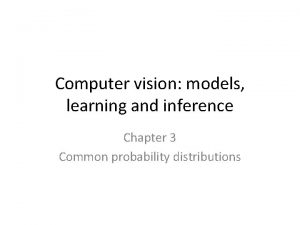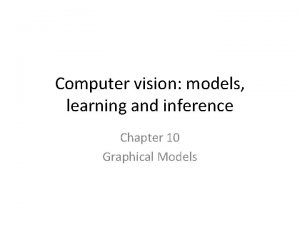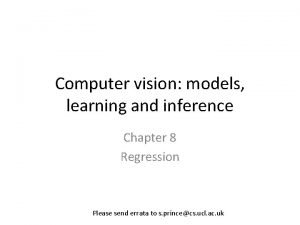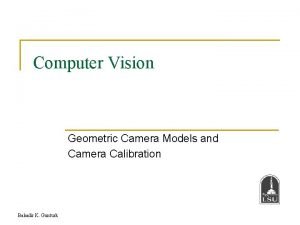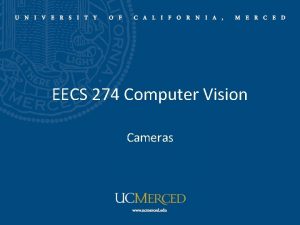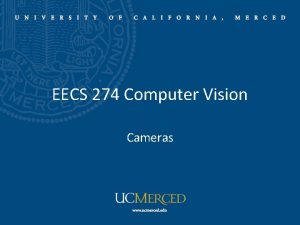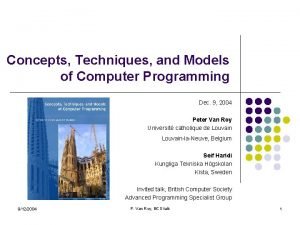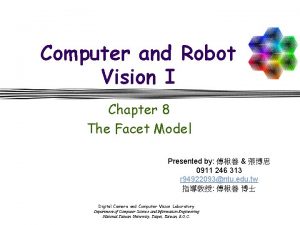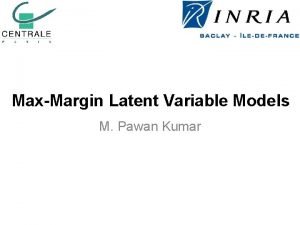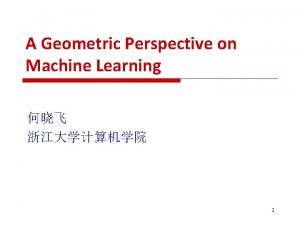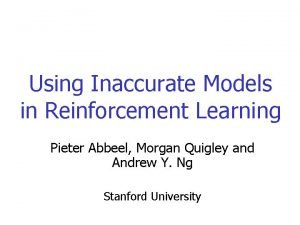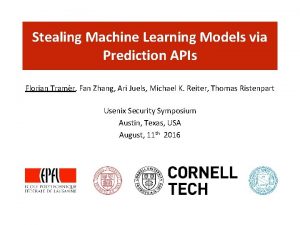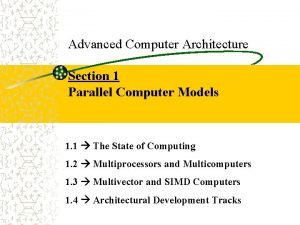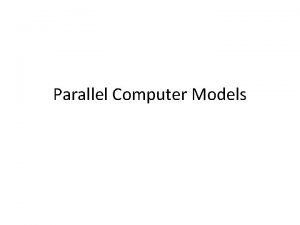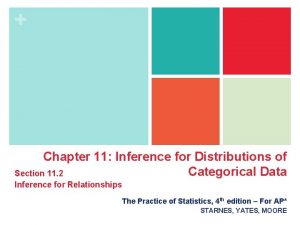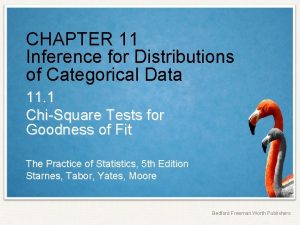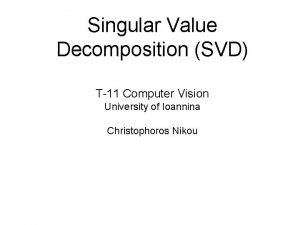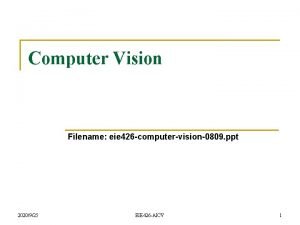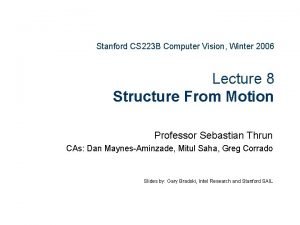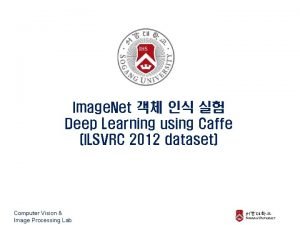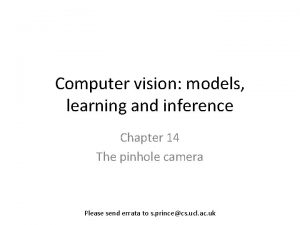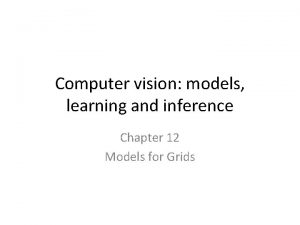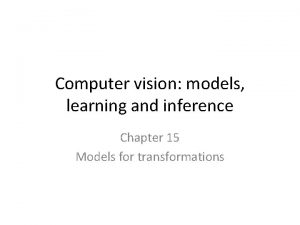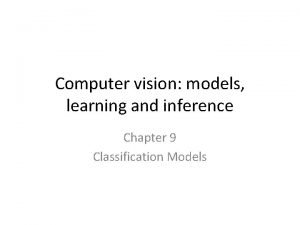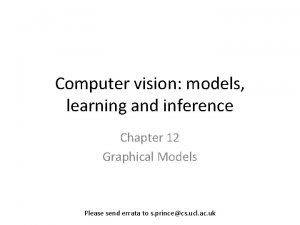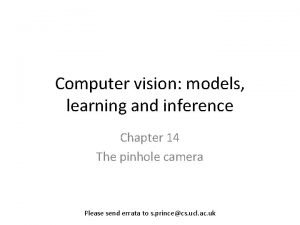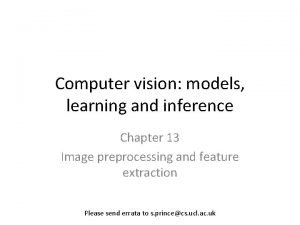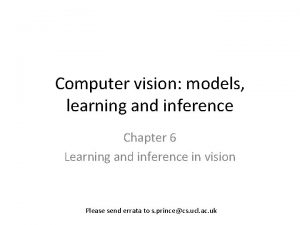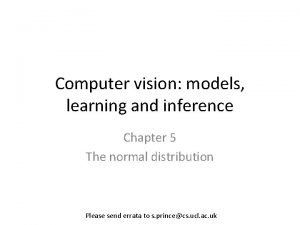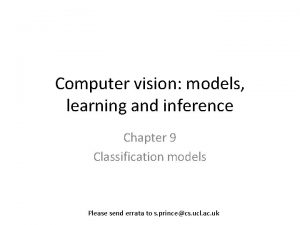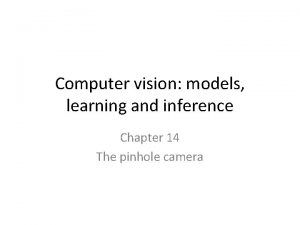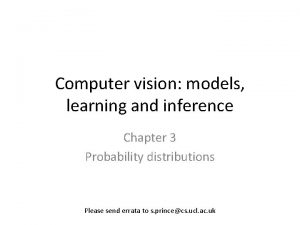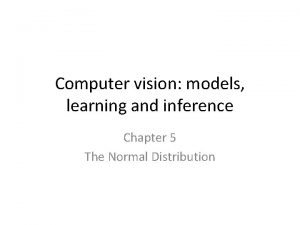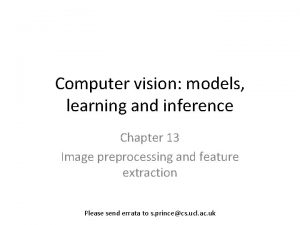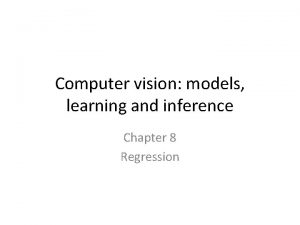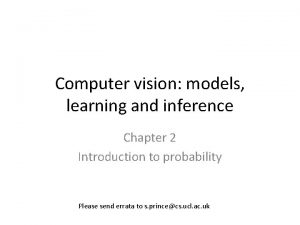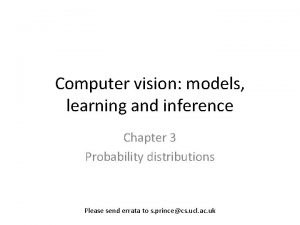Computer vision models learning and inference Chapter 6


















































- Slides: 50

Computer vision: models, learning and inference Chapter 6 Learning and Inference in Vision

2 Structure • Computer vision models –Two types of model • Worked example 1: Regression • Worked example 2: Classification • Which type should we choose? • Applications Computer vision: models, learning and inference. © 2011 Simon J. D. Prince 2

Computer vision models • Observe measured data, x • Draw inferences from it about state of world, w Examples: –Observe adjacent frames in video sequence –Infer camera motion –Observe image of face –Infer identity Computer vision: models, learning and inference. 3 –Observe images from two displaced cameras

Regression vs. Classification • Observe measured data, x • Draw inferences from it about world, w When the world state w is continuous we’ll call this regression When the world state w is discrete we call this classification Computer vision: models, learning and inference. 4

Ambiguity of visual world • Unfortunately visual measurements may be compatible with more than one world state w –Measurement process is noisy –Inherent ambiguity in visual data • Conclusion: the best we can do is compute a probability distribution Pr(w|x) over possible states of world Computer vision: models, learning and inference. 5

Refined goal of computer vision • Take observations x • Return probability distribution Pr(w|x) over possible worlds compatible with data (not always tractable – might have to settle for an approximation to this distribution, samples from it, or the best (MAP) solution for w) Computer vision: models, learning and inference. 6

Components of solution We need • A model that mathematically relates the visual data x to the world state w. Model specifies family of relationships, particular relationship depends on parameters q • A learning algorithm: fits parameters q from paired training examples xi, wi • An inference algorithm: uses model to return Computer vision: models, learning and inference. 7 Pr(w|x) given new observed data x.

Types of Model The model mathematically relates the visual data x to the world state w. Two main categories of model 1. Model contingency of the world on the data Pr(w|x) 2. Model contingency of data on world Pr(x|w) Computer vision: models, learning and inference. 8

Generative vs. Discriminative 1. Model contingency of the world on the data Pr(w|x) (DISCRIMINATIVE MODEL) 2. Model contingency of data on world Pr(x|w) (GENERATIVE MODELS) Generative as probability model over data and so when we draw samples from model, we GENERATE new data Computer vision: models, learning and inference. 9

Type 1: Model Pr(w|x) Discriminative How to model Pr(w|x)? 1. Choose an appropriate form for Pr(w) 2. Make parameters a function of x 3. Function takes parameters q that define its shape Learning algorithm: learn parameters q from training data x, w Inference algorithm: just evaluate Pr(w|x) Computer vision: models, learning and inference. 10

Type 2: Pr(x|w) - Generative How to model Pr(x|w)? 1. Choose an appropriate form for Pr(x) 2. Make parameters a function of w 3. Function takes parameters q that define its shape Learning algorithm: learn parameters q from training data x, w Inference algorithm: Define prior Pr(w) and then compute Pr(w|x) using Bayes’ rule Computer vision: models, learning and inference. 11

Summary Two ifferent types of model depend on the quantity of interest: 1. Pr(w|x) Discriminative 2. Pr(w|x) Generative Inference in discriminative models easy as we directly model posterior Pr(w|x). Generative models require more complex inference process using Bayes’ rule Computer vision: models, learning and inference. 12

1 3 Structure • Computer vision models –Two types of model • Worked example 1: Regression • Worked example 2: Classification • Which type should we choose? • Applications Computer vision: models, learning and inference. © 2011 Simon J. D. Prince 13

Worked example 1: Regression Consider simple case where • we make a univariate continuous measurement x • use this to predict a univariate continuous state w (regression as world state is continuous) Computer vision: models, learning and inference. 14

Regression application 1: Pose from Silhouette Computer vision: models, learning and inference. 15

Regression application 2: Head pose estimation Computer vision: models, learning and inference. 16

Worked example 1: Regression Consider simple case where • we make a univariate continuous measurement x • use this to predict a univariate continuous state w (regression as world state is continuous) Computer vision: models, learning and inference. 17

Type 1: Model Pr(w|x) Discriminative How to model Pr(w|x)? 1. Choose an appropriate form for Pr(w) 2. Make parameters a function of x 3. Function takes parameters q that define its shape Learning algorithm: learn parameters q from training data x, w Inference algorithm: just evaluate Pr(w|x) Computer vision: models, learning and inference. 18

Type 1: Model Pr(w|x) Discriminative How to model Pr(w|x)? 1. Choose an appropriate form for Pr(w) 2. Make parameters a function of x 3. Function takes parameters q that define its shape 1. Choose normal distribution over w 2. Make mean m linear function of x (variance constant) 1. Parameters are f 0, f 1, s 2. This model is called linear regression. Computer vision: models, learning and inference. 19

Parameters are y-offset, slope and variance Computer vision: models, learning and inference. 20

Learning algorithm: learn q from training data x, y. E. g. MAP Computer vision: models, learning and inference. 21

rence algorithm: just evaluate Pr(w|x) for new data x Computer vision: models, learning and inference. 22

Type 2: Pr(x|w) - Generative How to model Pr(x|w)? 1. Choose an appropriate form for Pr(x) 2. Make parameters a function of w 3. Function takes parameters q that define its shape Learning algorithm: learn parameters q from training data x, w Inference algorithm: Define prior Pr(w) and then compute Pr(w|x) using Bayes’ rule Computer vision: models, learning and inference. 23

Type 2: Pr(x|w) - Generative How to model Pr(x|w)? 1. Choose an appropriate form for Pr(x) 2. Make parameters a function of w 3. Function takes parameters q that define its shape 1. Choose normal distribution over x 2. Make mean m linear function of w (variance constant) 1. Parameter are f 0, f 1, s 2. Computer vision: models, learning and inference. 24

Learning algorithm: learn q from training data x, w. e. g. MAP Computer vision: models, learning and inference. 25

Pr(x|w) x Pr(w) = Pr(x, w) Can get back to joint probability Pr(x, y) Computer vision: models, learning and inference. 26

Inference algorithm: compute Pr(w|x) using Bayes rule Computer vision: models, learning and inference. 27

2 8 Structure • Computer vision models –Three types of model • Worked example 1: Regression • Worked example 2: Classification • Which type should we choose? • Applications Computer vision: models, learning and inference. © 2011 Simon J. D. Prince 28

Worked example 2: Classification Consider simple case where • we make a univariate continuous measurement x • use this to predict a discrete binary world w (classification as world state is discrete) Computer vision: models, learning and inference. 29

Classification Example 1: Face Detection Computer vision: models, learning and inference. 30

Classification Example 2: Pedestrian Detection Computer vision: models, learning and inference. 31

Classification Example 3: Face Recognition Computer vision: models, learning and inference. 32

Classification Example 4: Semantic Segmentation Computer vision: models, learning and inference. 33

Worked example 2: Classification Consider simple case where • we make a univariate continuous measurement x • use this to predict a discrete binary world w (classification as world state is discrete) Computer vision: models, learning and inference. 34

Type 1: Model Pr(w|x) Discriminative How to model Pr(w|x)? –Choose an appropriate form for Pr(w) –Make parameters a function of x –Function takes parameters q that define its shape Learning algorithm: learn parameters q from training data x, w Inference algorithm: just evaluate Pr(w|x) Computer vision: models, learning and inference. 35

Type 1: Model Pr(w|x) Discriminative How to model Pr(w|x)? 1. Choose an appropriate form for Pr(w) 2. Make parameters a function of x 3. Function takes parameters q that define its shape 1. Choose Bernoulli dist. for Pr(w) 2. Make parameters a function of x 1. Function takes parameters f 0 and f 1 This model is called logistic regression. Computer vision: models, learning and inference. 36

Two parameters Learning by standard methods (ML, MAP, Bayesian) Inference: Just evaluate Pr(w|x) Computer vision: models, learning and inference. 37

Type 2: Pr(x|w) - Generative How to model Pr(x|w)? 1. Choose an appropriate form for Pr(x) 2. Make parameters a function of w 3. Function takes parameters q that define its shape Learning algorithm: learn parameters q from training data x, w Inference algorithm: Define prior Pr(w) and then compute Pr(w|x) using Bayes’ rule Computer vision: models, learning and inference. 38

Type 2: Pr(x|w) Generative How to model Pr(x|w)? 1. Choose an appropriate form for Pr(x) 2. Make parameters a function of w 3. Function takes parameters q that define its shape 1. Choose a Gaussian distribution for Pr(x) 2. Make parameters a function of discrete binary w 3. Function takes parameters m 0, m 1, s 20, s 21 that define its shape Computer vision: models, learning and inference. 39

Learn parameters m 0, m 1, s 20, s 21 that define its shape Computer vision: models, learning and inference. 40

Inference algorithm: Define prior Pr(w) and then compute Pr(w|x) using Bayes’ rule Computer vision: models, learning and inference. 41

4 2 Structure • Computer vision models –Three types of model • Worked example 1: Regression • Worked example 2: Classification • Which type should we choose? • Applications Computer vision: models, learning and inference. © 2011 Simon J. D. Prince 42

Which type of model to use? 1. Generative methods model data – costly and many aspects of data may have no influence on world state Computer vision: models, learning and inference. 43

Which type of model to use? 1. Inference simple in discriminative models 2. Data really is generated from world – generative matches this 3. If missing data, then generative preferred 4. Generative allows imposition of prior knowledge specified by user Computer vision: models, learning and inference. 44

4 5 Structure • Computer vision models –Three types of model • Worked example 1: Regression • Worked example 2: Classification • Which type should we choose? • Applications Computer vision: models, learning and inference. © 2011 Simon J. D. Prince 45

4 6 Application: Skin Detection Computer vision: models, learning and inference. © 2011 Simon J. D. Prince 46

4 7 Application: Background subtraction Computer vision: models, learning and inference. © 2011 Simon J. D. Prince 47

4 8 Application: Background subtraction But consider this scene in which the foliage is blowing in the wind. A normal distribution is not good enough! Need a way to make more Computer vision: models, learning and inference. © 2011 Simon J. D. Prince 48

4 9 Future Plan • Seen two types of model –Probability density function –Linear regression –Logistic regression • Next three chapters concern these models Computer vision: models, learning and inference. © 2011 Simon J. D. Prince 49

Conclusion • To do computer vision we build a model relating the image data x to the world state that we wish to estimate w • Three types of model • Model Pr(w|x) -- discriminative • Model Pr(w|x) – generative Computer vision: models, learning and inference. 50
 Computer vision: models, learning, and inference
Computer vision: models, learning, and inference Computer vision: models, learning, and inference
Computer vision: models, learning, and inference Computer vision: models, learning, and inference pdf
Computer vision: models, learning, and inference pdf Computer vision: models, learning, and inference
Computer vision: models, learning, and inference Coordinate rotation matrix
Coordinate rotation matrix Camera models in computer vision
Camera models in computer vision Camera models in computer vision
Camera models in computer vision Cs766
Cs766 What is the difference between model and semi modal
What is the difference between model and semi modal Cuadro comparativo e-learning y b-learning
Cuadro comparativo e-learning y b-learning Kubernetes gpgpu
Kubernetes gpgpu Concepts techniques and models of computer programming
Concepts techniques and models of computer programming Linear programming models: graphical and computer methods
Linear programming models: graphical and computer methods Mathematical foundations of computer graphics and vision
Mathematical foundations of computer graphics and vision Computer and robot vision
Computer and robot vision Self-paced learning for latent variable models
Self-paced learning for latent variable models Type of machine learning models
Type of machine learning models Geometric models in machine learning
Geometric models in machine learning Using inaccurate models in reinforcement learning
Using inaccurate models in reinforcement learning Inversion attacks
Inversion attacks Modes of learning
Modes of learning Stealing machine learning models via prediction apis
Stealing machine learning models via prediction apis Cmy and hsv color model
Cmy and hsv color model Parallel computer models
Parallel computer models Lighting models in computer graphics
Lighting models in computer graphics Computer graphics models are now commonly used for making ?
Computer graphics models are now commonly used for making ? Computational model in computer architecture
Computational model in computer architecture Bernstein condition for parallelism
Bernstein condition for parallelism Chapter 11 inference for distributions of categorical data
Chapter 11 inference for distributions of categorical data Chapter 12 inference for proportions answers
Chapter 12 inference for proportions answers Chapter 11 inference for distributions of categorical data
Chapter 11 inference for distributions of categorical data Chapter 11 inference for distributions of categorical data
Chapter 11 inference for distributions of categorical data Tdsb vision for learning
Tdsb vision for learning Vision for learning tdsb
Vision for learning tdsb 16-385 computer vision
16-385 computer vision Kalman filter computer vision
Kalman filter computer vision Svd computer vision
Svd computer vision Berkeley computer vision
Berkeley computer vision Multiple view geometry tutorial
Multiple view geometry tutorial Font detector
Font detector Radiometry in computer vision
Radiometry in computer vision Linear algebra for computer vision
Linear algebra for computer vision Computer vision
Computer vision Computer vision ppt
Computer vision ppt Computer vision stanford
Computer vision stanford Multiple view geometry in computer vision
Multiple view geometry in computer vision Python cognitive services
Python cognitive services Computer vision slides
Computer vision slides Caffe computer vision
Caffe computer vision Computer vision final exam
Computer vision final exam Computer vision sift
Computer vision sift

